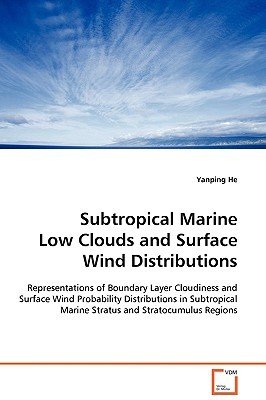
- We will send in 10–14 business days.
- Author: Yanping He
- Publisher: VDM Verlag
- ISBN-10: 3639096738
- ISBN-13: 9783639096736
- Format: 15.2 x 22.9 x 0.9 cm, softcover
- Language: English
- SAVE -10% with code: EXTRA
Subtropical Marine Low Clouds and Surface Wind Distributions (e-book) (used book) | bookbook.eu
Reviews
Description
This book is designed to represent subtropical marine stratus and stratocumulus (MSC) and surface winds in a simple but physical consistent way, which has applications in climate modeling and offshore wind energy development. A simple low cloud cover scheme is developed in Chapter 2, in which the variation of MSC is formulated by connecting low cloud amount with lower tropospheric stability (LTS), large-scale subsidence, and dynamical transport of available dry inhibition energy below trade wind inversion. The new scheme produces realistic seasonal and inter-annual variations of MSC amounts and systematically reduces the NCAR CAM3.1 model biases as shown in Chapter 3. The lower troposphere available thermal inhibition energy is also shown in Chapter 4 to be a skillful predictor in diagnosing MSC in monthly and seasonal time-scales. The influence of MSC, ocean SST, and large-scale divergence on surface wind probability distribution are addressed in Chapter 5 using satellite observations and a simple stochastic model, which can successfully reproduce the observed mean, the standard deviation, and skewness of surface wind speeds in the southeast Pacific.
EXTRA 10 % discount with code: EXTRA
The promotion ends in 20d.19:31:46
The discount code is valid when purchasing from 10 €. Discounts do not stack.
- Author: Yanping He
- Publisher: VDM Verlag
- ISBN-10: 3639096738
- ISBN-13: 9783639096736
- Format: 15.2 x 22.9 x 0.9 cm, softcover
- Language: English English
This book is designed to represent subtropical marine stratus and stratocumulus (MSC) and surface winds in a simple but physical consistent way, which has applications in climate modeling and offshore wind energy development. A simple low cloud cover scheme is developed in Chapter 2, in which the variation of MSC is formulated by connecting low cloud amount with lower tropospheric stability (LTS), large-scale subsidence, and dynamical transport of available dry inhibition energy below trade wind inversion. The new scheme produces realistic seasonal and inter-annual variations of MSC amounts and systematically reduces the NCAR CAM3.1 model biases as shown in Chapter 3. The lower troposphere available thermal inhibition energy is also shown in Chapter 4 to be a skillful predictor in diagnosing MSC in monthly and seasonal time-scales. The influence of MSC, ocean SST, and large-scale divergence on surface wind probability distribution are addressed in Chapter 5 using satellite observations and a simple stochastic model, which can successfully reproduce the observed mean, the standard deviation, and skewness of surface wind speeds in the southeast Pacific.


Reviews